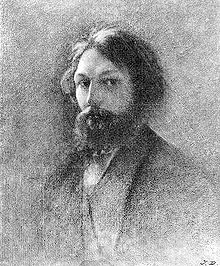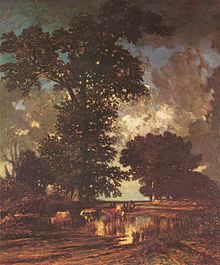Jules Dupré
Jules Dupré (born April 5, 1811 in Nantes , † October 6, 1889 in L'Isle-Adam ) was one of the most important French landscape painters of the Barbizon School . He is considered the founder of modern French landscape painting.
Life
Dupré initially followed his father's profession, a porcelain manufacturer, but then turned to landscape painting. In 1831 he exhibited for the first time in the Paris Salon , five landscapes based on motifs from the Haute-Vienne department . Since then he has brought almost only French landscapes to the exhibition , but from 1835 to 1839 also some from England . On a trip to England he had studied the landscape painting of John Constable , which had a strong influence on his work.
After he had not exhibited publicly for a long time, twelve pictures by Dupré were on display at the World Exhibition of 1867 , then again after a long break at the national exhibition of 1883, eight landscapes. He was one of the main exponents of the so-called paysage intimate , ie the new direction in French landscape painting, which did not cultivate the “beautiful view” or a general idealism, but tried to win every piece of landscape its peculiar mood in color, air and light.
The main thing for him was the truth of the clay, and in order to achieve this he painted so heavily pastose that his pictures sometimes look like reliefs . The lighting also played an important role, and in particular he knew how to portray the sunset with a strong poetic charm. He was an officer of the Order of the Legion of Honor .
His brother Léon Victor Dupré , born in Limoges and a student of his, was also a landscape painter.
Works (selection)
Individual evidence
- ↑ The great lexicon of painting . Georg Westermann Verlag, Braunschweig 1982, ISBN 3-14-509078-X , p. 181 f .
Web links
| personal data | |
|---|---|
| SURNAME | Dupré, Jules |
| BRIEF DESCRIPTION | French landscape painter |
| DATE OF BIRTH | April 5, 1811 |
| PLACE OF BIRTH | Nantes |
| DATE OF DEATH | October 6, 1889 |
| Place of death | L'Isle-Adam |







